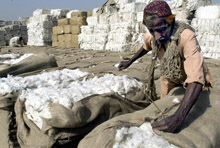
Typical street scene in Santa Ana, El Salvador. (Photo: iStock)
IMF Survey: IMF to Lend Pakistan $3.2 Billion More to Support Social Costs, Build Reserves
August 7, 2009
- Higher lending to build official reserves, support targeted spending on poor
- Pakistan managing to stabilize economy, exchange rate
- Government to press ahead with tax, electricity reforms
The IMF’s Executive Board agreed to increase lending to Pakistan by an extra $3.2 billion to fund priority spending and help the government provide assistance to nearly three million people displaced by military operations and a difficult security situation.

Cotton consignment in Karachi, Pakistan, where rebound in agriculture helped maintain growth in positive territory (photo: Aamir Qureshi/AFP)
TARGETED SOCIAL SPENDING
The Board reviewed progress under a $7.6 billion Stand-By Arrangement for Pakistan that was agreed in November last year. During the August 7 discussion, Directors agreed to increase lending by $3.2 billion, after a request from the Pakistan government to meet the country’s increased balance of payments needs resulting from higher oil prices. Pakistan will also benefit from the proposed allocation of Special Drawing Rights, which will supplement its reserves.
About $1.4 billion of the new IMF resources will be made available, on a temporary basis, for budget financing during 2009/10. The main purpose is to provide bridge financing until donor support pledged at an April donors conference in Tokyo starts to come in. Donors pledged $5.7 billion to Pakistan over three years.
Like many other emerging markets, Pakistan has been hit by the global economic and financial crisis. “But, despite the challenges brought on by the global downturn and an extraordinarily difficult security situation, the government has managed to stabilize the economy,” said Adnan Mazarei, head of the IMF’s mission to Pakistan.
Anemic growth
Buffeted by a volatile political and security situation, Pakistan’s growth has been anemic. and the near-term outlook for economic activity, especially manufacturing, remains weak.
A rebound in agriculture on the back of a bumper wheat crop helped maintain growth in positive territory. However, with increasing weakness in large-scale manufacturing, exports, and private sector credit, the estimate of real GDP growth for 2008/09 has been lowered from 2.5 to 2.0 percent and is projected by the IMF at 3 percent for 2009/10. Moreover, the Federal Bureau of Statistics recently revised down real GDP growth for 2007/08 from 5.8 to 4.1 percent, indicating that the economic slowdown began before 2008/09.
Inflation has continued to decline, but it remains high with core inflation at just below 16 percent in June.
Signs of stability
However, with imports contracting sharply and workers’ remittances continuing to grow, Pakistan’s external current account position has improved somewhat. Despite lower exports, the current account deficit is estimated to have declined by more than $5 billion (3.2 percentage points of GDP) in 2008/09 due to a significant decline in imports, higher workers’ remittances, and increased support from the United States.
As in many emerging markets, the financial account remains weak. With the global economic slowdown and political and security uncertainties, net financial flows declined by $3.2 billion compared to 2007/08. Inflows of foreign direct investment, at $3.4 billion, were $2 billion lower and the net portfolio outflow was recorded at about $1.2 billion compared with a small inflow in 2007/08. Official lending was somewhat lower than expected, reaching $4.3 billion ($1.2 billion higher than in 2007/08).
Despite the political and security problems and some policy slippages, the government of Pakistan has managed to stabilize the economy—the exchange rate has been broadly stable in recent months and the international reserves position has strengthened to $8.3 billion in July compared to $3.5 billion at end-October 2008.
Reform agenda
The government has also set in motion important reforms to improve tax administration, restore financial viability to the electricity sector, strengthen the social safety net, while at the same time maintaining fiscal discipline by eliminating non-priority investment spending.
Fiscal issues, however, remain a key concern for Pakistan. Pakistan authorities have renewed their commitment to press ahead with reforms, especially the introduction of a broad-based value-added tax (VAT) to correct the structural shortcomings in Pakistan’s tax system, which relies on a very narrow tax base.
The introduction of a broad-based VAT in mid-2010 is a key pillar of their fiscal strategy. They are also pursuing a strategy to improve tax administration. “A credible tax reform is needed to ensure fiscal sustainability and to create fiscal space for expanding the social safety net, and increasing investment in human and physical capital,” the IMF said in its report on the economy.
The authorities also aim to address the problems in the electricity sector. A plan has been prepared to eliminate the stock of “circular” debt in the energy sector. The government has agreed with World Bank and Asian Development Bank staffs on a schedule to increase electricity tariffs in the course of 2009/10 and eliminate tariff differential subsidies in 2010/11.
Support for the poor
Achieving economic recovery in a way that ensures social stability and adequate support for the poor is a key goal of Pakistan’s program. Cash transfers to the poor are projected to increase in the next year, and the government is working with the World Bank to develop specific measures to protect the poor from the effects of Pakistan’s economic woes, fallout from the security operations, and the global crisis.
The 2009/10 budget has been constructed with a view to providing adequate space for priority spending. In particular, the IMF said the authorities should ensure that the redistributive function of the budget is consistent with the government’s social policy objectives, with spending on internally displaced people, support for poor households, and other well-targeted social spending taking precedence.
Comments on this article should be sent to imfsurvey@imf.org


